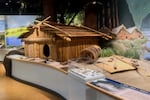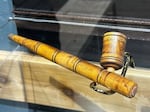
At the Museum of Natural and Cultural History on the University of Oregon campus, an early Native American dwelling and tools are on display.
Brian Bull/KLCC
After a roughly four-year hiatus, Gov. Tina Kotek announced Tuesday that she’s reviving a task force dedicated to inventorying Native American items in state and public collections across Oregon, via executive order.
“Tribes should have access to information about cultural items held in storage or on display at state agencies, state universities, colleges, and public schools,” said Kotek in a news release. “It is time to renew this important work and continue to strengthen our essential government-to-government relationship with the nine sovereign nations.”
In 2017, then-Gov. Kate Brown established the Task Force on Oregon Tribal Cultural Items. Its 16 members were from all nine federally-recognized tribes within Oregon and also included government, university and law enforcement officials.
The task force issued its first report to Brown in October 2019, making Oregon the first state in the U.S. to share survey findings on tribal items.
But once the COVID-19 pandemic appeared in Oregon and spread, the task force’s activities were paused.
Jesse Beers is the cultural stewardship manager for the Confederated Tribes of Coos, Lower Umpqua, and Siuslaw Indians (CTCLUSI), and was a member of the original task force.
“I really want to convey how happy I am that this is being reconvened,” Beers told KLCC. “There’s items that the state may hold that tribes aren’t aware of, and there’s knowledge that tribes have the state is unaware of, so it’s a way of building relationships.”

Jesse Beers, CTCLUSI's cultural stewardship manager, at an estuary development site outside of Florence, OR.
Brian Bull/KLCC
CTCLUSI officials selected Beers to be their representative on the previous task force. It’s unknown at this time if the newly-convened one under Kotek’s administration will bring back the original members, start with new ones, or a combination of the two. The members will be appointed at a later date, and be convened by the Governor’s Tribal Affairs Director in partnership with the Legislative Commission on Indian Services.
Members will include representatives of the federally-recognized tribes in Oregon, the State Historic Preservation Office, the state’s public universities and colleges, primary or secondary public schools, a state agency director, and the Legislative Commission on Indian Services. Additional members may be selected by the governor as well.
This new task force will also submit annual reports to the Governor’s Office starting in 2025.
Kotek’s Executive Order 24-06 replaces Brown’s Executive Order 17-12 issued in 2017.
In March 2020, the previous “Task Force on Oregon Tribal Cultural Items” began surveying the state’s public universities and community colleges, but halted it once the pandemic prompted COVID protocols. Kotek’s release says the resumption of that effort will “continue the process for identifying best practices for gathering information about these types of cultural items associated with Oregon Tribes.”

An antique wooden pipe on display at CTCLUSI's tribal headquarters in Coos Bay. Tribes want items such as these in state agencies, and public colleges and universities accounted for, and the Task Force on Oregon Tribal Cultural Items is seen as an important part of that initiative.
Brian Bull/KLCC
Furthermore, the release says the task force will work on developing the “most appropriate next steps” for determining the appropriate custodians, storage, and display of such items. These can include archival materials such as recordings, maps, diaries, artifacts, and field notes, to human remains and funerary objects.
“Things were accumulated, items were accumulated, and artifacts were accumulated. And also documents are accumulated that pertain to tribal history and culture, because the tribes never left this place. We’re still here,” said Beers. “And so defining what those items are, what are the work of the task force and then asking each state agency under the direction of the governor to inventory what they have.”
Beers added that one other initiative the task force was looking into before COVID hit was looking into estate sales managed by the state. Whether that is still on the agenda will be determined once the re-activated task force meets and outlines its priorities.
Across the U.S., Native Americans are pressing museums, galleries and archives to account for their collections of Indigenous items. Many were gathered during the colonization of North America, which includes objects plundered from burial mounds or deceptively acquired from tribal members. Incorporating tribal perspectives is seen as vital to presenting historical and cultural items in a more accurate and sensitive context, as institutions have been accused of presenting them in ways that are dated, stereotypical, and inaccurate.
Copyright 2024, KLCC.